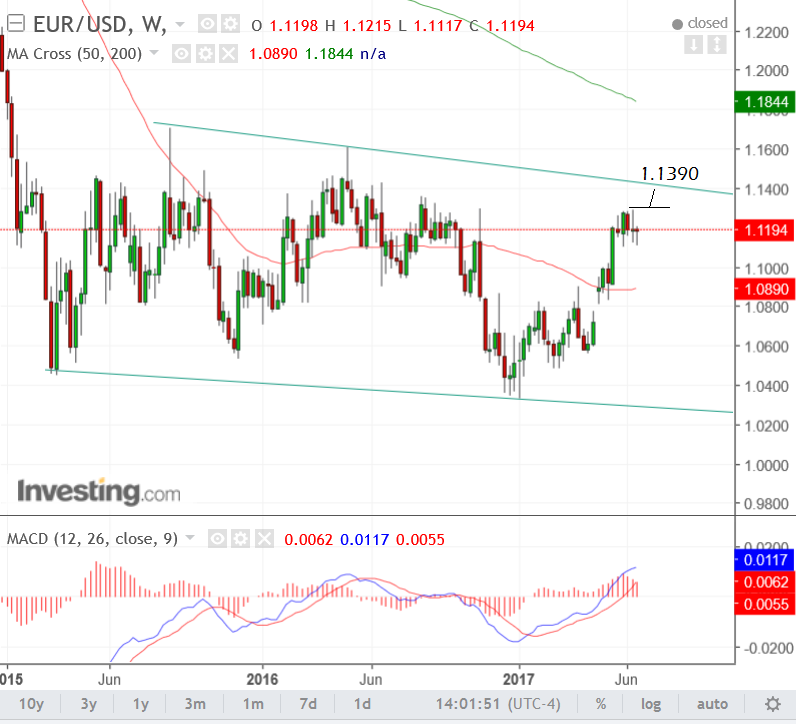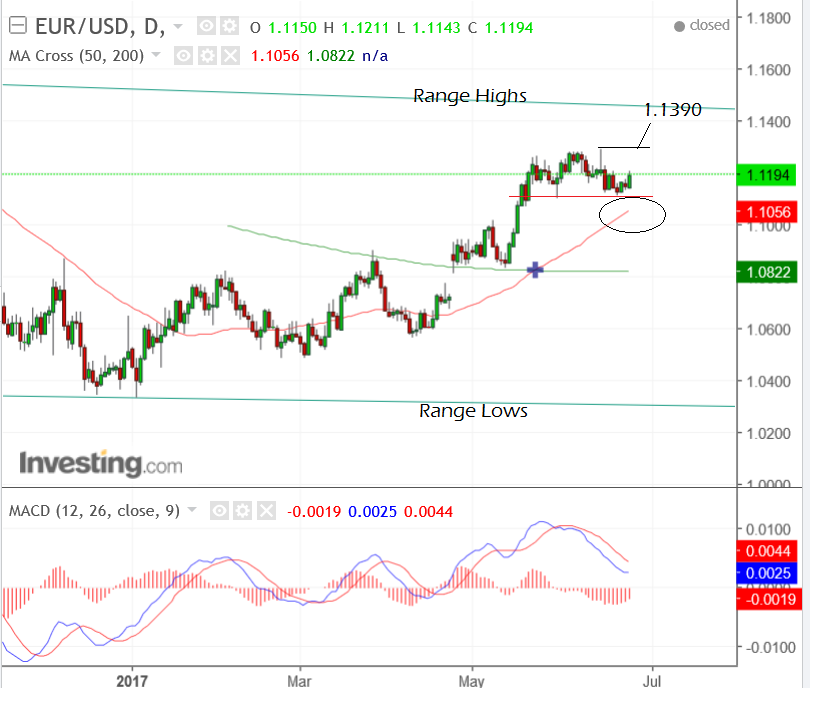EUR/USD Tipped to Maintain Upside Bias in Coming Week

The Euro to US Dollar exchange rate (EUR/USD) continues rising within its range between the lows of 1.0300 and the ceiling at 1.1450.
Easing Eurozone political risks and hints that the European Central Bank (ECB) are prepping for a tightening cycle are two factors supporting the uptrend, as are concerns the Federal Reserve may have gotten too far ahead of itself in raising interest rates and might slow the process down.
Concerning the technical outlook, EUR/USD has shown signs of weakness recently and has pulled back to the 1.1100 support level before recovering.
Thus we believe the short-term uptrend is still intact, as noted in previous forecasts.
Even if it were to break down the 50-day moving average (circled) situated at 1.1056 would provide a robust obstacle to deeper weakness and probably indicates a continued bias to more upside.

Assuming a break above the 1.1287 highs we would expect the pair to move up to a target at 1.1390 just below the R2 monthly pivot at 1.1395.
Monthly pivots are levels closely watched by traders who often trade the exchange rate when it touches them, normally the counter-trend pull-back, as more sellers enter the market in expectation of lower prices.
Although the MACD looks bearish and is falling on the daily chart it is well above the zero-line on the weekly chart.

However, analyst Kamal Sharma at Bank of America Merrill Lynch Global Research believes EUR/USD is likely to face headwinds going forward and recommends traders sell the exchange rate.
"We believe that the near-term headwinds to further EUR/USD gains are mounting," says Sharma. "The unexpected hawkish tone from the Fed which accompanied its June rate hike decision has reinforced the divergence between US and Euro Area rate differentials whilst the ongoing message from ECB officials suggests a very gradual pace in QE tapering."
Rhetoric from the Federal Reserve has remained hawkish of late and further speakers are due this week.
"We continue to believe that the Fed will tighten policy faster than US rates markets currently predict," says Sharma.
The current soft patch in US data has been a concern for markets but we note that US macro data surprises are now approaching levels which have previously marked a reversal with the spread between Euro Area data surprises approaching historically wide levels.
Bank of America say this suggests that incremental bad news on US macro is currently in the price.
Data and Events for the Euro
The main release for the Euro will be June inflation data at 10.00 BST on Friday, June 30.
Current estimates have Core CPI rising a basis point to 1.0% from June 2016 and Headline CPI slowing slightly to 1.2%, from 1.4% in 2016.
Canadian investment bank TD Securities expect core inflation to stay at 0.9% and headline inflation to fall even more steeply to 1.1%.
Inflation is important for the Euro via the impact it has on the policy choices made at the ECB. Higher inflation could prompt higher interest rates at the ECB while falling inflation would see the status-quo maintained.
Higher interest rates tend to be positive for the Euro as they would likely attract capital to the Eurozone as investors seek out increased yield. It would also slow the shipping of cheap Euros to other countries in order to fund investments.
Much of the fall in headline inflation is likely due the recent decline in oil prices.
“The decline comes from fading base effects on energy prices, where the contribution to the headline rate is falling from 0.9ppts in February to only 0.1-0.2ppts now,” said TD.
Another key event for the Euro will be Mario Draghi’s speech at 14.30 on Wednesday.
Data and Events for the Dollar
For the Dollar, like the Euro, inflation will be key.
The US Federal Reserve’s preferred gauge of inflation, Personal Consumption Expenditure (PCE), is scheduled to be released at 13.30 BST on Friday, June 30, and is likely to be the main data event for the Dollar in the week ahead.
The market has turned a little doubtful over whether the Fed is going to continue raising interest rates recently and the PCE release will help to provide perspective on these misgivings.
If the PCE comes out disappointingly low then this could fuel doubts about Fed policy, and lead to a sell-off in the Dollar.
The Dollar will move in correlation with inflation and interest rate expectations, rising if they are higher and falling if they are lower, since higher interest rates tend to attract more foreign capital, and vice versa.
The consensus analyst expectation is for PCE(Core) to slow slightly in May to 1.4% from 1.5% in May 2016, and to rise 0.1% from 0.2% on a monthly basis.
“We look for headline and core PCE inflation to slip further, with the core index falling to 1.4% y/y due to several one-offs (cellphone services, apparel) along with continued weakness in vehicle and healthcare services prices. Spending and income should be solid and supportive of robust real PCE growth near 3%. But the weak core inflation print should ultimately drive a dovish market response, reinforcing markets' skepticism over future rate hikes,” said Canadian IB TD Securities.
Beyond that there is housing data, commentary from Fed officials and the Michigan Sentiment Gauge in the week ahead.










